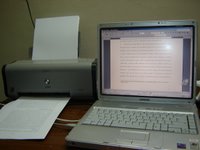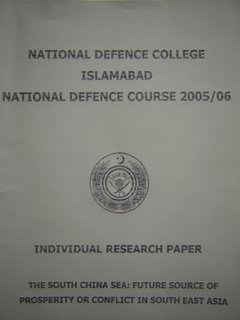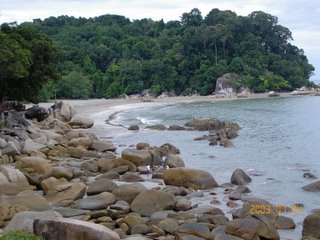
Today we had a great guest speaker; in the form of President of Afghanistan, Hamid Karzai. He went on record with the local media, so I can safely relate some of the points he has said and not to worry about the college "non-attribution" policy. He was dressed in the standard
shalwa kameez with the trademark green robe and
songkok. He spoke in good English. He started the talk by reminiscing his time in the 70s. When he was living in Quetta, whenever he came to Islamabad, he used to take a walk from Faisal mosque to NDC - then under construction.
Specific to Afghanistan, he said, the nation had suffered 30 years of misery, war and destruction, a loss of resources, and most importantly, a loss of time. They suffered under Soviet occupation and later the Taliban. The Taliban turned out to be the biggest misery for Afghanistan because they intensified the war. The Taliban also enraged the population. They destroyed some of the country's educational institution and stopped children from going to school. They also beat women for simple things like wearing white shoes outdoors or even shot and killed them, just for being outdoors with their husbands. Quite a number were publicly hanged, watched by the thousands (I remember seeing a documentary on this event on Astro). Without being too specific, he mentioned it was a flawed policy of Pakistan to support the Taliban. The world stood and watched while Afghanistan suffered. Then came 9/11 and suddenly Afghanistan became relevent. Within a month and a half the evil forces of Taliban was defeated. Apart from the outside assistance, the will of the Afghan people was the key, as by then they did not support the Taliban. The President emphasized many times, that the will of the Afghan people are always strong as further evidenced in the last election. He told a story about voting in last elections, saying that one old lady had shown up to vote and wanted to vote twice, once on her own, and once for her daughter, who was at home giving birth to a child. The poll workers told her she could not do this, the law prohibited it. So, the old lady voted, and then walked home, walked back the same day with her daughter who had just given birth, so that she could vote. A journalist asked another old lady why she had made two long arduous trips just to cast one vote - to which she answered that she was voting to ensure a better future for her children and grandchildren.
The President later turned to the crux of Afghan - Pakistan relations. The tone was more on economic and the need of regional peace and stability. He said globalised world should bring all the nations in the region together. Five years ago exports from Pakistan were $25 million. 3 years ago they had risen to $600 million and today those exports stand at $1.2 billion. This expansion means more jobs, more companies, more shops and labor - in the end it means Pakistani's are better off. The average Pakistani has more money today than 5 years ago. This trade, if expanded to the Central Asian Region could reach $4 or $5 billion. He made a simple but effective remark by saying that a stable and prosperous Afghanistan is good for Pakistan. When he talked about the concept of "strategic depth", I imagined it took all the Pakistani military officers by surprise because the officers were used to that concept as something military in nature. The President was however referring the concept in economic terms. Afghanistan is going to be a better partner as it grows. A poor friend is a liability. Pakistan and Afghanistan must walk together into the future - a future of prosperity and education. He seeks this future as a human being, as an Afghan, and as a Muslim and a neighbor.
Later he related an interesting stroy. When he went back to Afghanistan from Quetta, he crossed the border on motorbike. The Taliban did not recognised him when he moved from villages to villages until Kandahar. He was fortunate. At the time also within a span of two hours from 9 to 11 in the morning, three events took place; he was elected as the interim president, the surrender of mullah omar's forces and an american bomb dropped near him!! (one of my US colleague at the college; a F16 driver was in Afghanistan at that time - maybe he was the pilot).
At the end, the President entertained six questions from the audience. Like before, I was not impressed by the questions posed. The questions were not fitting and the audience really missed a great opportunity. One question was about the fencing at the border to check the terrorists. The President assertively answered by saying that the fence will not solve the problem with terrorism. The answer should be finding the source and what the fence is going to do is to divide the people. On another question about Iranian nuclearisation, he said he never believe on the need of nuclear weapons. I intended to seek the president's opinion on the state of Muslim ummah, in the wake of the gulf between the west and Islam, but we ran out of time. My opportunity was reduced to only shaking hand with him. Overall, a good session. Wishing to have more time like this.







